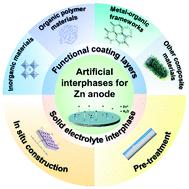Our official English website, www.x-mol.net, welcomes your feedback! (Note: you will need to create a separate account there.)
Artificial interphase engineering to stabilize aqueous zinc metal anodes
Nanoscale ( IF 6.7 ) Pub Date : 2021-11-11 , DOI: 10.1039/d1nr06058a Zichao Yan 1 , Wenli Xin 1 , Zhiqiang Zhu 1
Nanoscale ( IF 6.7 ) Pub Date : 2021-11-11 , DOI: 10.1039/d1nr06058a Zichao Yan 1 , Wenli Xin 1 , Zhiqiang Zhu 1
Affiliation

|
Aqueous Zn-ion system combining the advantages of energy density, intrinsic safety, and environmental benignity, has been regarded as a promising power source for future electronics. Besides cathodes and electrolytes, more attention should be paid to stabilizing zinc metal anodes since the main challenges in current aqueous Zn-ion batteries are still the hydrogen evolution and dendrite growth of the zinc anode. Thereupon, artificial interphase engineering that integrates the highly tunable, selectable, and controllable characteristics becomes one of the most effective ways to stabilize zinc anodes. In this mini-review, state-of-the-art knowledge on the rational interphase engineering of aqueous zinc metal anodes in the functional layer coating and in situ solid electrolyte interphase formation are covered. The main focus of this work is to summarize the most recent development of artificial interphases in chemical composition, structure, and function. The potential issues and perspectives regarding materials and methods are presented.
中文翻译:

稳定含水锌金属阳极的人工界面工程
水系锌离子系统结合了能量密度、本质安全性和环境友好性等优点,被认为是未来电子产品的一种很有前途的电源。除了正极和电解质之外,还应更多地关注稳定锌金属负极,因为目前水性锌离子电池的主要挑战仍然是锌负极的析氢和枝晶生长。因此,集高度可调、可选和可控特性于一体的人工界面工程成为稳定锌阳极最有效的方法之一。在这篇简短的评论中,关于功能层涂层和原位中水性锌金属阳极合理界面工程的最新知识固体电解质中间相的形成也包括在内。这项工作的主要重点是总结人工界面在化学成分、结构和功能方面的最新发展。介绍了有关材料和方法的潜在问题和观点。
更新日期:2021-11-25
中文翻译:

稳定含水锌金属阳极的人工界面工程
水系锌离子系统结合了能量密度、本质安全性和环境友好性等优点,被认为是未来电子产品的一种很有前途的电源。除了正极和电解质之外,还应更多地关注稳定锌金属负极,因为目前水性锌离子电池的主要挑战仍然是锌负极的析氢和枝晶生长。因此,集高度可调、可选和可控特性于一体的人工界面工程成为稳定锌阳极最有效的方法之一。在这篇简短的评论中,关于功能层涂层和原位中水性锌金属阳极合理界面工程的最新知识固体电解质中间相的形成也包括在内。这项工作的主要重点是总结人工界面在化学成分、结构和功能方面的最新发展。介绍了有关材料和方法的潜在问题和观点。


























 京公网安备 11010802027423号
京公网安备 11010802027423号